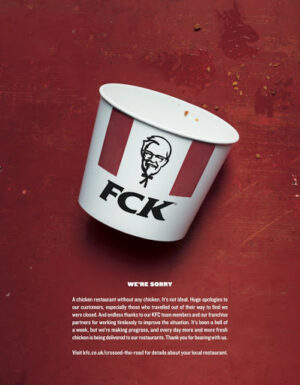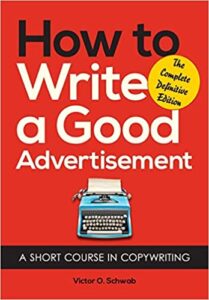KFC – we’re all familiar with the restaurant chain which is famous for its “finger lickin’ good” chicken and its Colonel Sanders logo.
The fast food chain serves millions of pieces of chicken around the globe annually, but when disaster struck in 2018 the restaurant used a risky and clever marketing campaign to salvage their reputation and keep their customers happy. Here’s how it all unfolded.
Where did all the chickens go?!
In 2017 KFC decided to cut ties with their long-term partner, food delivery specialist Bidvest Logistics in favour of signing a contract with Quick Service Logistics and DHL. This came as a shock to many in the industry as the latter companies are more known for their home-delivery services, rather than their knowledge and expertise in the food delivery sector.
KFC and DHL promised that they would “revolutionise” the UK food-service supply chain with a new focus on “innovation, quality & reliability”, but within only a few weeks of taking over delivery management, the new system was already showing cracks. DHL was struggling to fulfill the orders from its sole operations centre in Rugby to all the KFC franchisees across the UK.
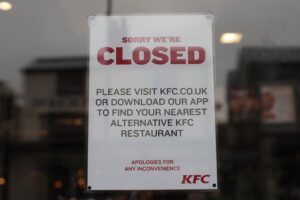 Then, the company’s worst nightmare happened. By mid-February 2018 restaurants were running out of key ingredients, including chicken, forcing hundreds of owners to close their restaurants.
Then, the company’s worst nightmare happened. By mid-February 2018 restaurants were running out of key ingredients, including chicken, forcing hundreds of owners to close their restaurants.
Customers were not happy, and by 21st February there was a staggering 53,000 mentions of the chicken shortage on social media. Hashtags such as #KFCCrisis and #ChickenCrisis were trending, with angry customers continuing to be frustrated at their inability to grab a bargain bucket of their favourite fried chicken.
The story gained huge news coverage, both locally and nationally. Customers were filmed gathering angrily outside their local branches, wondering when they were going to re-open. They were filmed live on camera stating that they were going to have to spend their money in Burger King instead.
What the cluck to do?
It was a PR disaster for KFC with memes, funny videos, and articles circulating online which mocked the brand and company, which by this point had 900 restaurants closed across the country.
KFC executives knew they had to act fast, and they turned to their marketing agency, Mother, for help in their darkest hour.
They outlined two major objectives for the marketing campaign:
- A mass apology to all their frustrated (and hungry) customers
- An explanation of why this had happened, and what they were doing to resolve the situation
Mother, which was quite new to working with KFC having only won the account less than a year earlier, decided that they would use print media as the medium for their campaign. They selected two well-known UK newspapers, The Sun, and The Metro.
The reason they selected Print as their medium of choice was that it allowed them to reach a large percentage of their customer base (both newspapers had a combined readership of almost 6 million) and because print as a medium is perceived as more trustworthy when compared to social media.
They knew that customers would not appreciate a dry, meaningless corporate apology. They wanted to use humor and down-to-earth honesty to apologise to their customers. The result was pure genius. Using a naughty anagram of KFC to perfectly capture how the company felt about the situation, they created a simple, funny, and honest advert that summed up the whole debacle.
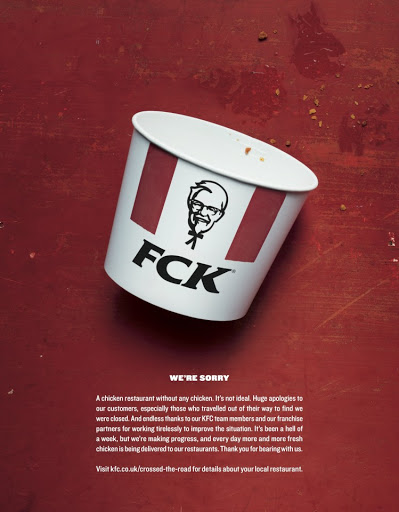
The FCK anagram was so clever, straight to the point, and more importantly, it was on-brand. The apology underneath read:
“We’re sorry. A chicken restaurant without any chicken is not ideal. Huge apologies to our customers, especially those who travelled out of their way to find we were closed. And endless thanks to our KFC team members and our franchise partners for working tirelessly to improve the situation. It’s been a hell of a week, but we’re making progress, and every day more and more fresh chicken is being delivered to our restaurants. Thank you for bearing with us.”
They even created a special website with a funny domain name – “kfc.co.uk/crossed-the-road” for customers to be able to get updates about their local results.
They followed this up with posts on social media that further pointed fun at themselves.
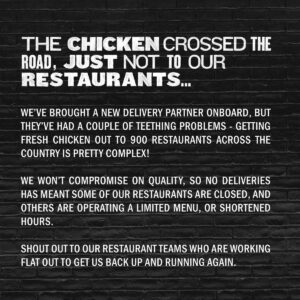
The reaction
The campaign was a huge success, prompting 700 press articles and discussions on television. This gave a combined audience of 797 million globally!
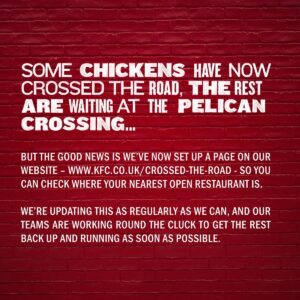
219 million social media users were exposed to their “FCK” image, giving the campaign a total global reach of more than 1 billion in less than 3 months. Not bad for a single press ad!
The campaign was also heralded as an excellent example of corporate crisis management and went on to win numerous marketing awards.
KFC went on to re-establish their partnership with Bidvest, and managed to get operations back to normal in the weeks that followed. Whilst they were getting restaurants back up and running they continued the campaign and its funny theme to update customers on the progress.
Why the campaign was so successful
The campaign was successful because the marketing team at Mother acted from the viewpoint that brands are like people. If you want to connect with a fellow human being you have to be open, sincere, honest, and transparent. That’s how you gain someone’s trust.
This campaign served to prove this point. By being honest about their mistakes and asking for forgiveness, KFC enabled their customers to relate to them on an emotional level, just as they would to another human being. As consumers, we want honest conversations, not dry, meaningless corporate speak. People appreciate honesty, and when you are brave enough to admit your mistakes they will warm to you even more.
This is definitely one of my favorite marketing campaigns. I’ve learned a lot about successful marketing and the importance of honesty, transparency, and accepting responsibility from three simple letters than I have from any marketing book or seminar.
Absolutely FCKing genius.

